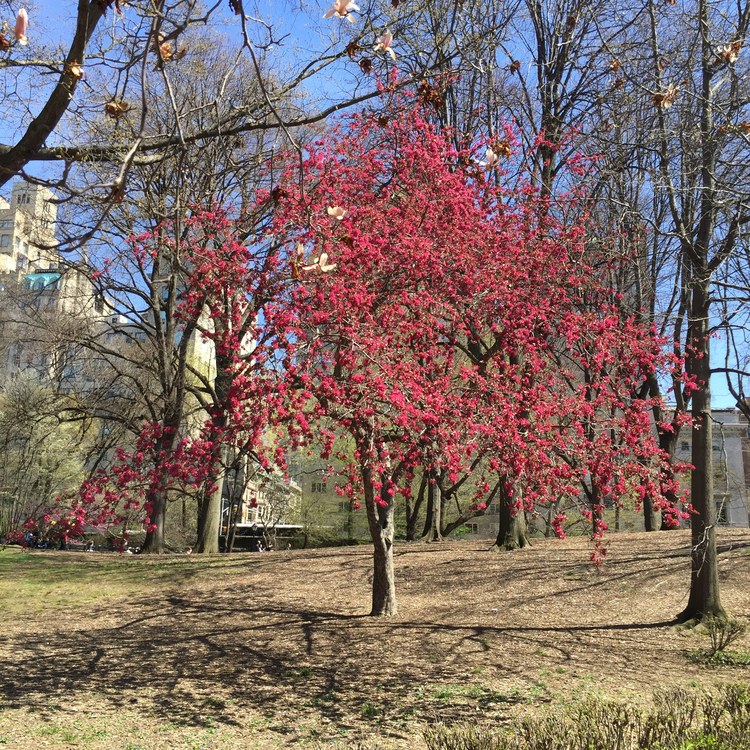After a whirlwind few months of non-stop travel, Gary and I decided to spend the weekend at our pied-à-terre in New York City. We took the Amtrak in from Boston (a trip I am learning to enjoy) and soon found ourselves surrounded by the hustle and bustle of the city. Upon arrival at our apartment, we were greeted by both the comfort of familiar things that we have collected through the years and the dust that comes with our infrequent use the place which can make it look a little lifeless. The best remedy? A quick trip to the market to purchase some orange tulips which immediately added some fresh color and a sense of presence.
On Friday, we took to the streets and set out for the Interior Design Building on 61st and 2nd to visit some of our favorite design resources which include John Rosselli, BK Antiques, Liz O'Brien, Duane, CJ Peters, Eric Appel, Lee Calicchio, Balsamo Antiques and Roark. Many of the furniture pieces in our Nantucket Home, featured in the May issue of House Beautiful, were found in this building. After a quick lunch at Fig & Olive where we enjoyed a selection of their delectable crostini, we visited the John Salibello showrooms on East 60th to investigate his latest collection of vintage lighting. It could not have been a nicer afternoon. The city just felt like it was in bloom and bursting with color.
Saturdays are always a fun day for us to take a break from work and visit museums for some inspiration. This weekend was no exception and, given that we live on the Upper East Side, we decided to visit the Metropolitan Museum of Art and see the current exhibition featuring the work of Elisabeth Louise Vigée Le Brun (French, 1755–1842), one of the finest 18th-century French painters/portraitist. Vigée Le Brun was a court favorite of Marie Antoinette and she achieved success in France and Europe during one of the most eventful, turbulent periods in European history. This is the first retrospective and only the second exhibition devoted to Vigée Le Brun in modern times. There are 80 works on view from European and American public and private collections. The portraits are amazing and show her development as an artist as played out against the story of her early life in France, her escape during the French Revolution and her ultimate return to her native country.
There could be not better follow-up to a visit to the museum than a stroll through Central Park. Created by legislation passed in 1853 and expanded in 1873, Central park consists of 843 acres of land in central Manhattan. As winners of an 1858 competition, soon-to-be famed national landscapers and architects Frederick Law Olmsted and Calvert Vaux were chosen to design the park and their work fostered what was to become an urban park movement in the country. Central Park was designated a National Historic Landmark in 1962 and is currently managed by the non-profit Central Park Conservancy.
Central Park is home to over 25,000 trees and many of the flowering trees were in bloom. The park has a stand of 1,700 American elms which, due to their isolation, have been protected from the Dutch elm disease that devastated many of this tree in its native range, including our favorite island of Nantucket. The park maintains a website (www.centralparknyc.org/tree-guide/) which provides all kinds of helpful information to identify various trees in the park. Can you this identify the beauty pictured above?
Conservatory Water was originally constructed as reflecting pool for a glass conservatory which was never built. The water body then evolved into the popular model boat pond, inspired by those in Parisian parks. On pleasant days, a variety of model ships, most remote-controlled, glide across the water. The sailboats are either privately owned or rented at a cart provided by the boathouse. It is at this spot that E.B. White's beloved character Stuart Little sailed his model sailboat to victory.
The copper-roofed boathouse features a cafe with a variety of light snacks and beverages, a delightful patio with beautiful, seasonal perennial planting beds.
Birders also like to gather at this location to search for signs of the famous Fifth Avenue red-tailed hawks.
On Sunday, with weather that turned out to be even more glorious than the day before, we decided to finally walk on The High Line, one of Manhattan's newest public parks. The High Line is built on a historic rail line elevated above the street on the West Side. It runs from West 34th Street to Gansevoort Street in the Meatpacking District. The High Line provides a great viewing platform to watch both the activity on the river as well as the evolving skyline on the lower West Side with all of its creative architecture.
When we disembarked, we explored the Meatpacking District. An interesting dynamic has developed during the last twenty years as designers, architects, artists, restauranteurs, and corporate headquarters have moved in alongside existing meatpacking plants. With the success of the The High Line, top-tier hotels as well as stores, restaurants, bars and boutiques have risen up to serve the many new visitors to the area. In 2015 the Whitney Museum, one of the City’s most well respected art institutions, made it's home in the Meatpacking District. It appears that this area will continue to develop and evolve, making it one of the most interesting parts of the city.
As the day came to a close, we made our way back to our apartment for the rare treat of a home-cooked meal after which we began to pack for our next adventure. A clue as to where we are headed....Cheerio mates!







